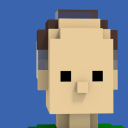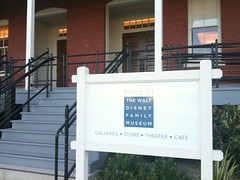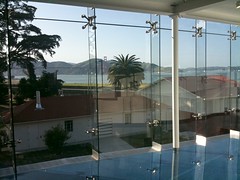The Walt Disney Family Museum
 My wife and I dropped the kids off at their grandparents for a little date. We headed to the movie theater, but changed our minds. Instead, we went to a coffee shop, did a little reading and people watching, and then went to the Walt Disney Family Museum.
My wife and I dropped the kids off at their grandparents for a little date. We headed to the movie theater, but changed our minds. Instead, we went to a coffee shop, did a little reading and people watching, and then went to the Walt Disney Family Museum.It's situated in the Presidio, and the entrance is very unassuming. We almost missed it, and we were looking for it as we drove by.
The museum is about Walt Disney's life and family. It'd have been boring for the kids, so it was a good thing that we went there ourselves. I found it very inspirational.
In a very modest way, I identified with the creative "individual contributor" Walt who worked at the Kansas City Film Ad Company. But he soon left to pursue bigger dreams and demonstrated a remarkable adaptability and drive to achieve his goals.
I appreciated that after feeling betrayed by a middle-man and losing the rights to work on Oswald the Lucky Rabbit along with losing a few animators, he swore to himself "no more middle-men," and created a new character to replace Oswald, Mickey Mouse. (The telegrams on display and voice-over narration by Walt Disney were fascinating.)
Before committing to the first ever feature animation, he produced an experimental short, The Old Mill, to test out the most experimental and risky parts of the new production. (They have a Multiplane Camera at the museum. It's big and impressive.) Testing out large architectures by prototyping is a technique still used in software development, so I was amused to see Disney use it in 1937.
It was also gratifying to see that Disney gave Snow White's animator a couple of months to experiment with animating the human form before asking for any production cels. (Disney had hired him because he was already a master at animating people.) That's a luxury we don't see in the creative disciplines enough.
Disney was an impressive visionary. Not only did he take animation from short to feature, he didn't feel threatened being in the theater business by television. Instead, he jumped right into it. He figured that T.V. was here to stay. And when he started in television, he filmed in color, because he figured that eventually color T.V.s would become popular. Boy, was he right.
In some places, the view from the Museum was just beautiful.
The museum funnels you from one room to another, and each room corresponds to a phase in Disney's life and career. Towards the end, there's a fantastic two-story room with a walkway that curves down towards a scale model of Disneyland. As you enter the room, you'll see a full-sized reproduction of his ridable miniature train, the Lilly Belle; and hanging from the roof is a Circle Vision camera. There was so much more, too. That room is magical.
There's a little more at the museum where you see some Disney television shows, and the Mickey Mouse Club. (I was struck by the fact that Disney's current production of child stars isn't all that different from the way they were selected then.)
The museum ends with the last few years of his life, and I was surprised to learn that his life and mine didn't overlap. Watching The Wonderful World of Disney when I was a kid was a big part of my life. Walt Disney was a part of my life.


Comments